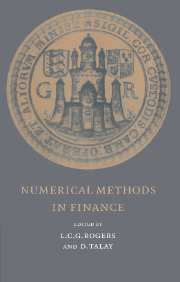Book contents
- Frontmatter
- Contents
- Contributors
- Introduction
- Convergence of Numerical Schemes for Degenerate Parabolic Equations Arising in Finance Theory
- Continuous-Time Monte Carlo Methods and Variance Reduction
- Recent Advances in Numerical Methods for Pricing Derivative Securities
- American Options: A Comparison of Numerical Methods
- Fast, Accurate and Inelegant Valuation of American Options
- Valuation of American Option in a Jump-diffusion Models
- Some Nonlinear Methods for Studying Far-from-the-money Contingent Claims
- Monte Carlo Methods for Stochastic Volatility Models
- Dynamic Optimization for a Mixed Portfolio with Transaction Costs
- Imperfect Markets and Backward Stochastic Differential Equations
- Reflected Backward SDEs and American Options
- Numerical Methods for Backward Stochastic Differential Equations
- Viscosity Solutions and Numerical Schemes for Investment/Consumption Models with Transaction Costs
- Does Volatility Jump or Just Diffuse? A Statistical Approach
- Martingale-Based Hedge Error Control
- The Use of Second-Order Stochastic Dominance To Bound European Call Prices: Theory and Results
Fast, Accurate and Inelegant Valuation of American Options
Published online by Cambridge University Press: 05 June 2012
- Frontmatter
- Contents
- Contributors
- Introduction
- Convergence of Numerical Schemes for Degenerate Parabolic Equations Arising in Finance Theory
- Continuous-Time Monte Carlo Methods and Variance Reduction
- Recent Advances in Numerical Methods for Pricing Derivative Securities
- American Options: A Comparison of Numerical Methods
- Fast, Accurate and Inelegant Valuation of American Options
- Valuation of American Option in a Jump-diffusion Models
- Some Nonlinear Methods for Studying Far-from-the-money Contingent Claims
- Monte Carlo Methods for Stochastic Volatility Models
- Dynamic Optimization for a Mixed Portfolio with Transaction Costs
- Imperfect Markets and Backward Stochastic Differential Equations
- Reflected Backward SDEs and American Options
- Numerical Methods for Backward Stochastic Differential Equations
- Viscosity Solutions and Numerical Schemes for Investment/Consumption Models with Transaction Costs
- Does Volatility Jump or Just Diffuse? A Statistical Approach
- Martingale-Based Hedge Error Control
- The Use of Second-Order Stochastic Dominance To Bound European Call Prices: Theory and Results
Summary
In this short article, we describe the pricing of an American option (call or put) on a share which may pay continuous dividends, using a method described by Broadie & Detemple (1997) as ‘not very elegant’. The method is simply to build a look-up table of option prices, which thus splits the problem of pricing American option prices into three sub-problems:
(A) accurate calculation of the values in the table;
(B) storage of the table, and access to it;
(C) rapid calculation of prices for given parameter values.
The most important problems are clearly B and C; in principle, we may take as long as necessary to fill up the table, since this calculation is done off-line, once only. Any of the methods discussed elsewhere in this volume by Broadie & Detemple (1997) and by AitSahalia & Carr (1997) could be used to compute the values in the table. We used the binomial method with 5000 time steps using Black-Scholes in the last step, as recommended by Broadie & Detemple.
It is worth remarking that by computing and storing the table of values, we are able to calculate greeks, and the exercise boundary with relatively little extra cost; this is a valuable advantage of this inelegant approach.
To describe the storage problem, let us first state the parametrisation which we used.
- Type
- Chapter
- Information
- Numerical Methods in Finance , pp. 88 - 92Publisher: Cambridge University PressPrint publication year: 1997
- 8
- Cited by



